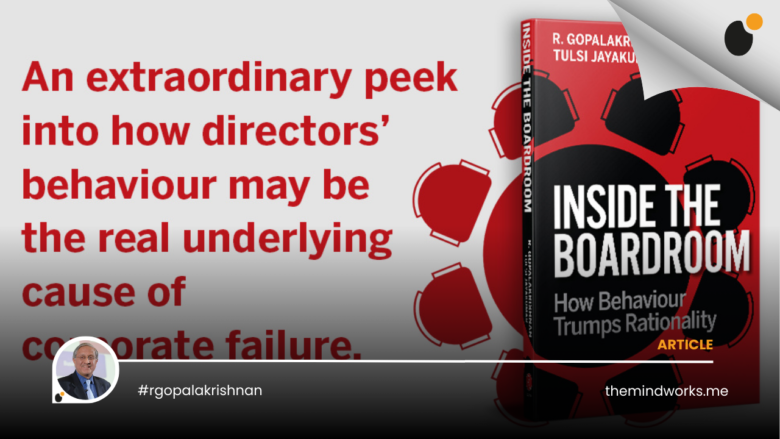TNIE (24)
To appear on 19-5-22
‘Transforming organizations’: a series in New Indian Express.
The excruciating pain of transformations
By R Gopalakrishnan
(The writer is an author and business commentator. His articles and videos can be accessed on his website www.themindworks.me and his email ID is rgopal@themindworks.me)
Organizational transformations are gut wrenching, and painful. There is no shortcut. Do not believe the many books advocating how to achieve a transformational change without pain. In fact, the leadership team must voluntarily seek out the pain to drive their transformation. Several years ago, while writing my first book, I was in search of a metaphor for organizational transformation. I found a metaphor from Nature. Butterflies are good ecological indicators. I learned a lot from my periodic visits to the Nilgiris.
In 1986, a scientist and conservationist called Larsen Torben conducted a butterfly survey of the Nilgiris. His study bears his name. He detected the existence of 301 varieties of butterflies in the Nilgiris. In 2018, the Tamil Nādu Forest Department conducted the next survey and added three new varieties. Scientific American (10th August 2012) explained graphically what happens to a hungry caterpillar, which has gorged itself with nutrients—a bit like a startup—when it begins to morph into a butterfly.
First, the voraciously over fed caterpillar digests its own body into a soup, rich with enzymes. Second, while this gut-wrenching digestion process leaves behind what looks like an amorphous mess, though it is not entirely so. Certain groups of cells survive because they contain the genetic code to grow back the body parts required for a mature life later. These cells are called imaginal discs. Third, these imaginal discs help the animal to reconstruct wings and muscles to break through the cocoon and emerge as the breath-takingly beautiful butterfly.
Apply these lessons from Nature to companies. The equivalent of imaginal discs is the embedded organizational culture—the unique characteristics of mindset, behaviors, and actions that define the very being of the company and must be preserved. How many startups think about the imaginal discs that they must embed in their startup? How many voluntarily subject themselves to a self-digestion process after they have gorged themselves with growth for a long period? Very few, I reckon, and that is why the survival rate among startups is so low.
Think of grownup companies for whom such ‘creative destruction’ is essential to survive and prosper in the long-term. The dramatic transformations of The Gap (records to apparel), Netflix (DVD rentals to streaming), Tiffany (stationery to jewelry) are worth reading. IBM subjected itself to a gut-wrenching transformation process in 1990s. It is so well described in Lou Gerstner’s book, ‘Who says elephants can’t dance.’ IBM survived and prospered. So did Apple in 1997. However, Kodak, Enron, and Lehman Brothers did not. These are a part of the archives in museums.
Jamseji Tata began his enterprise as a trading and textile company. For growth, he grew into steelmaking and hydro power generation. For culture, he embedded the mindset and behavior of social responsibility (imaginal discs) by, inter alia, endowing the Indian Institute of Science. His statement is eponymous, “In a free enterprise, the community is not just another stakeholder in the business, but, in fact, the very purpose of its existence.”
His successor, Dorabji, brought to fruition the unfulfilled ambitions of his father in steel and hydro power generation before he diversified the enterprise into cement, construction, banking, insurance, and allied areas. The imaginal discs of corporate philanthropy were strengthened by investments, among others, in cancer research and a hospital.
Future successors, notably JRD Tata, grew the enterprise into aviation, chemicals, truck-making, and thermal power. All through the century, textiles got deemphasized, shifted from trading to manufacturing. Entry into the financial services businesses were overtaken by regulatory events. The imaginal discs of social commitment were strengthened through long-term modification of the companies’ articles of association, and the establishment of TIFR, TISS, and the NCPA.
In the most recent years, the group exited textiles, cement, soaps, and a few others. The enterprise globalized the business and entered futuristic businesses like information technology, communications, and passenger cars. The enterprise imaginal discs were strengthened through increased funds for the social agenda of Tata Trusts, promoting a national chain of cancer hospitals, and the impactful deployment of company CSR funds.
While these developments may read like a list of accomplishments, they are mere dots of history. I can state from experience that the process was slow and painful. The inevitable reduction of the portfolio was indeed gut-wrenching, and the new portfolio grew out of the entrepreneurial moves. All through the century and more, the imaginal discs helped to promote enterprise, strengthening its distinctive culture of community orientation.
No transformation can happen without pain.



